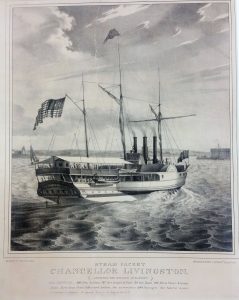The lithograph of the steamer CHANCELLOR LIVINGSTON is a fine example of an early black and white lithograph at Mystic Seaport. A group of print aficionados recently visited Curator Fred Calabretta for a look at some of the Museum’s finer prints and the print seen below was pointed out as a fine example from one of the earliest lithography companies in America.

Lithography in the United States started coming into its own in the 1820’s and the firm of William and John Pendleton in Boston was one of the premier producers of lithographs at the time, employing and training a host of young artists, including Fitz Hugh (now known as Fitz Henry) Lane, Moses Swett, Benjamin Nutting and others. Nathaniel Currier of Currier and Ives got his early training there beginning at the age of 15.
The steamboat CHANCELLOR LIVINGSTON was built in New York in 1816 and was used on the Hudson River route from New York to Albany and in 1825 headed the procession of boats to New York from Albany after the official opening of the Erie Canal. In 1827 she was sold to go into service on Long Island Sound, but needed to be rebuilt first, giving her the appearance that you see above.
We can date this print pretty accurately to the spring of 1828 for two reasons. The print shows her going into Newport, Rhode Island and it was in the spring of that year that she began her New York to Providence run. Also, the artist that produced the image for the lithograph was Moses Swett who left Pendleton’s that year to join the Senefelder Lithographic Co. His first lithograph for the company appeared in June of 1828, so it seems to be a pretty tight window in which this print would have been published.
The Museum boasts a remarkable print collection pertaining to the American maritime experience and this one is certainly one of the pioneering pieces.